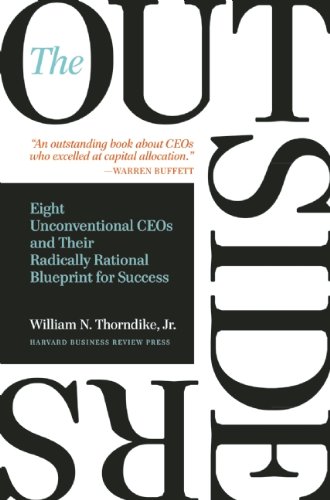

This article is an excerpt from the Shortform summary of "The Outsiders" by William N. Thorndike, Jr. Shortform has the world's best summaries of books you should be reading.
Like this article? Sign up for a free trial here .
How can a CEO becomes a great CEO? Can a COO learn better management practices to increase profits?
In The Outsiders, author William Thorndike analyzes the management styles and business decisions of eight successful CEOs who all had unorthodox management styles to determine that qualities of a CEO. These Outsider CEOs all thought outside the box, but they had in common the management style and qualities of a good CEO.
Quality of a Good CEO #1: Capital Allocation Knowledge
One of the most important qualities of a CEO is knowing about capital allocation and how to deploy it.
Most CEOs and most management books focus on the former. In contrast, Henry Singleton of Teledyne and the other outsider CEOs in the book focused on the latter. Rather than seeing themselves as company operators, the outsider CEOs saw themselves as investors and capital allocators first and foremost.
Despite the importance of capital allocation, little training is devoted to it. Business schools don’t feature capital allocation in curricula, and CEOs are promoted from functional roles (like product or marketing) without strong experience with investment in the business. Outsider CEOs saw it as their core job.
Quality of a Good CEO #2: Strong Management
Beyond capital allocation decisions, the outsider CEOs ran their businesses in unorthodox ways. These were important qualities of a CEO.
Decentralization
In their management of people and business units, outsider CEOs were relentlessly decentralized. They hired entrepreneurial operators for their business lines and left them alone. They kept a skeleton staff at headquarters, which reduced overhead and anxiety about office politics—the way to get ahead in the company was to outperform in your business unit.
Examples:
- Teledyne employed over 40,000 people but had fewer than 50 at its headquarters.
- Warren Buffett of Berkshire Hathaway rarely expects managers of his portfolio companies to contact him unless they have questions.
In contrast, typical companies tend to bulk up headquarters, featuring layers of vice presidents and MBAs. Not only does this increase overhead, but it also encourages office politics.
Decentralization also came in the form of spin-offs and tracking stocks. Instead of being buried within a large conglomerate, spin-offs gave individual business units more autonomy and better-aligned incentives with management.
Frugality
This may seem like an obvious one of the qualities of a CEO, but you’d be surprised. To outsider CEOs, cash was vital to the business, since it could be redeployed in their capital allocation strategies. Therefore, outsider CEOs cut operating expenses to a minimum. They avoided typical corporate perks like private cars and airline seats and kept headcount lean and efficient. When they acquired companies, they instilled this lean culture into the new company.
Focus on Cash Flow
Outsider CEOs resisted focusing on reported earnings, which present a muddled reflection of company performance because of capital expenditures, acquisitions, and other accounting artifacts. Instead, they focused on cash flow and then-innovative metrics like EBITDA (earnings before interest, taxes, depreciation, and amortization). This affected their operations deeply, from how they financed acquisitions to their compensation schemes for employees.
This relentless focus on cash flow also allowed them to avoid counterproductive distractions, such as costly acquisitions for the sake of growth that would later prove unprofitable.
Focus on Shareholder Returns
Typical CEOs let their egos get involved in strategic decisions. They enjoy empire building, growing revenue and headcount without concern for profit or long-term outcomes.
In contrast, outsider CEOs focused on shareholder value as their top priority. Having low egos, they didn’t hesitate to shrink the size of the company if it meant better returns to shareholders. For instance, Henry Singleton of Teledyne actively spun out businesses, believing they would independently perform better than under one large umbrella. This reduced the size of Teledyne but improved total shareholder performance.
Minimal Interactions with Investors
Outsider CEOs saw investor relations as a waste of time. They spent little time talking to Wall Street and managing expectations. Instead, they preferred to spend their time on the business. Most of the companies were situated outside the financial Northeast, in places like Omaha and Denver, where they would be insulated from the conventional wisdom of Wall Street.
No Particular Stroke of Luck
Outsider CEOs outperformed because of how they managed their businesses, not because of idiosyncratic strokes of luck, like intellectual property advantages or groundbreaking new ideas. Knowing how to manage is one of the most important qualities of a CEO. Other than management, they didn’t have any discernible advantages over their peers, and so their outsized performance can be attributed directly to their management and capital allocation strategies.
In contrast, some high-profile CEOs like Steve Jobs or Mark Zuckerberg had highly unusual circumstances. They had powerful new ideas taking advantage of technology trends, and they executed the ideas relentlessly. These situations are unlike those facing most business managers, and so lessons of a Steve Jobs or Zuckerberg are rarely generalizable to the business community at large.
Strong COOs as Partners
Another one of the qualities of a good CEO was having a strong COO. Among outsider CEOs, there was a pattern of having COOs who focused on day-to-day operations, while the CEO focused on long-term strategy and capital allocation. In essence, the COO generated the free cash flow, and the CEO spent it.
Examples:
- Capital Cities Broadcasting: Tom Murphy was CEO and the capital allocator. Dan Burke was COO and managed their media stations.
- Teledyne: Henry Singleton was CEO and the capital allocator. George Roberts was President and enforced results at its portfolio companies.
- Washington Post: Katharine Graham was CEO. Dick Simmons was COO and demanded operational excellence from its newspaper and media properties
Flexibility
Outsider CEOs tended to be strategically flexible, changing company strategy as the circumstances required. Rather than adhering to a preset strategy, outsider CEOs evaluated all possible options at each point in time, then chose the option that was best. This flexibility is one of the qualities of a good CEO.
For example, General Dynamics aggressively sold business lines like Cessna during one phase of the company’s turnaround, then decades later reversed course and acquired large businesses like Gulfstream when the environment had changed.
Likewise, at one time, share buybacks might be the best use of cash; in another time, using high-priced stock to buy companies might be preferable.
Personal Negotiations
The outsider CEOs tended to negotiate directly instead of through a layer of advisers. This is an often overlooked fact of the qualities of a CEO.
Examples:
- When running Ralston Purina, Stiritz made his acquisitions through direct contact with the sellers, avoiding auctions whenever he could.
- Warren Buffett avoids auctions for businesses. Instead, he prefers that owners call him and offer a price, with Buffett returning his answer within 5 minutes.
Focusing on the Important Factors
When making capital allocation decisions, outsider CEOs avoided complicated financial models and pages of analysis, which they knew to be imprecise. Instead, they tended to simplify understanding of a business down to a handful of key assumptions—market growth trends, competitive dynamics, and cash flow. This allowed them to make fast decisions when an opportunity appeared.
Quality of a Good CEO #3: Right Personality
The outsider CEOs also showed patterns to their personalities that informed how they ran their businesses. The Outsider CEOs profiled also had these qualities of a CEO in common.
Independent Thinkers
Outsider CEOs preferred to come to their own conclusions instead of following conventional wisdom. They were analytical and rational about their businesses. All were quantitative people, with more having engineering degrees than MBAs.
New to the Job
The CEOs featured in the book were first-time CEOs, with little management experience. Only two had MBAs. In fact, many were new to their industries. This inexperience might have helped their management, as they were unbound by conventional wisdom and built their practices independently, from first principle.
Understated
Outsider CEOs were humble and did not seek the spotlight. They avoided magazine covers and public talks. They weren’t considered charismatic. They were not household names in business, and so few people other than sophisticated investors and company fans know about them. They lived seemingly boring lives and were happily married. They were patient and tolerated waiting long periods of time for compelling opportunities to arise.
Again, this did not mean timidness. When outsider CEOs saw a great opportunity, they acted boldly and decisively, one of many important qualities of a CEO.
The qualities of a good CEO are a combination of strategy, management style, and personality. To achieve the qualities of a good CEO means thinking in an unorthodox way, jut like the eight Outsider CEOs did in order to achieve results.

———End of Preview———
Like what you just read? Read the rest of the world's best summary of William N. Thorndike, Jr's "The Outsiders" at Shortform .
Here's what you'll find in our full The Outsiders summary :
- What great CEOs like Warren Buffett do that average CEOs don't
- How to master the art of capital allocation
- How to be a great manager that your team is excited to work with






